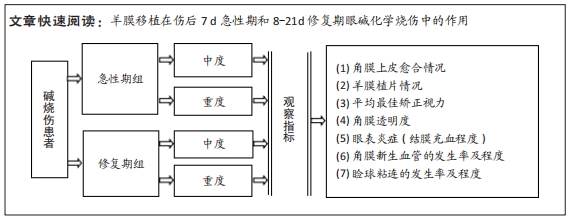3.1 眼碱化学烧伤的病程进展 对于眼组织化学烧伤,目前国内外对于其分期标准并无统一意见,谢立信[24]结合受伤时间、病情及治疗原则将其分为3期:急性期(早期)、修复和损伤共存期(中期)、病情稳定期(后期)。急性期主要指伤后1周内,表现为组织的急性缺血坏死和无菌性炎症渗出,角膜上皮缺损的区域会出现大量多形核细胞浸润,导致角膜基质水肿、上皮脱落,1周内可出现2次多形核细胞浸润高峰,第1次高峰在伤后24 h,可在3 d后减弱,第2次高峰则在伤后7 d,此时的炎症细胞主要是在角膜周边的深基质和上皮缺损区域的浅中层。而在修复期和损伤共存期(中期)主要是伤后第2周至3-6个月,炎性细胞浸润释放大量炎性因子,胶原纤维被胶原酶溶解,此期常因角膜基质蛋白溶解出现角膜溃疡甚至穿孔,缺损的角膜上皮及溃疡经久不愈,组织不断的增生和修复过程不可避免的会出现角膜新生血管长入角膜甚至伴有严重的睑球粘连发生,进而对视力造成进一步损害。病情稳定期(后期)是指在伤后3-6个月,患者的预后情况主要取决于烧伤的程度及早期给予治疗的方式,此期的组织创伤修复已趋于稳定,由于角膜缘干细胞的缺损,重度烧伤患者可出现角膜血管翳覆盖整个烧伤区域,睑球黏连及继发性青光眼。
3.2 羊膜移植治疗眼表化学烧伤的评价 对于眼碱化学烧伤的患者,临床上以往传统的治疗方法是给予常规的药物治疗,只有在角膜即将溶解穿孔时才给予清创或角膜移植术,但术后往往由于角膜缘干细胞功能的缺乏或角膜缘周围血管血供不足导致植片再次溶解或植片血管化。现如今羊膜已成功用于部分角膜缘干细胞缺乏状态的眼表重建(继发于化学烧伤、热烧伤、stevens-johnson综合征和各种病因的持续性上皮缺损)[16-17]。据文献报道,羊膜移植在Ⅱ级和Ⅲ级化学烧伤的早期(5 d内)预后更好,角膜混浊、上皮愈合速度和角膜缘干细胞缺乏发生率都较中晚期理想[25]。羊膜治疗急性和慢性化学眼损伤,轻度至中度损伤成功率达80%。在重度损伤中,羊膜移植可重建结膜表面,避免睑球粘连的发生并减轻角膜缘基质炎症。因此对于慢性且严重的化学损伤,在使用诸如角膜缘干细胞移植之类的难度系数较高且排斥风险较高的治疗措施之前,羊膜移植是一种可尝试的简单治疗方法。
此次研究所选择的急性期和修复期进行羊膜移植治疗的眼碱化学烧伤患者,角膜上皮化率为66%,低于PRABHASAWAT等[25]的研究得出羊膜移植治疗的角膜上皮化率为69.2%,可能是由于其研究纳入的病例数较少(21眼),且纳入研究时间基线不同,此次研究纳入的部分患者受伤时间较长,错过促进最佳上皮愈合时机,导致病情迁延。GOMES等[26]和SHIMAZAKI等[27]的研究也报告了较高的成功率,但其在手术中使用了羊膜移植联合同种异体或自体角膜缘干细胞移植。
此次研究术后眼表炎症程度、角膜透明度、疼痛缓解度及术后3个月最终稳定的矫正视力均较术前有所改善,同其他文献报道一致。根据不同程度化学烧伤羊膜重建眼表疗效分布(表11)观察,中度眼碱化学烧伤的预后相比重度要好。角膜新生血管和睑球粘连是重度眼碱化学烧伤后的主要并发症,由TANDON等[28]进行的临床试验评估了100例患者:50例Ⅱ级和Ⅲ级损伤(中度病例)和50例IV级损伤(重度病例),将常规眼药水点眼治疗和羊膜移植手术治疗对比。他们得出结论,由于广泛的角膜缘缺血和干细胞缺乏,羊膜移植在严重化学损伤中的作用受到限制。两组之间在最终的睑球粘连形成或血管形成方面无差异。继而得出结论:羊膜移植的短期益处不太可能防止化学损伤后继发的长期并发症。羊膜移植在重度眼部化学损伤病例中的作用,一些文献也报道过[29-30],重度烧伤患者本身角膜上皮缺损面积较大,角膜基质炎症细胞浸润更为严重,若单次单层的羊膜植片可能无法及时发挥作用,通过多次、复层的羊膜植片,也可使羊膜作用于角膜基质,使基质蛋白黏附,促进角膜上皮细胞的移形,首先稳定眼表微环境,为二期眼表重建打造基础。
3.3 多次羊膜移植 相比于轻中度的眼碱化学烧伤,重度烧伤往往是由于强碱造成,且由强碱造成的角结膜组织的损伤修复进程十分漫长。由于角膜持续性上皮缺损形成的溃疡深度可能达基质层,角膜间质细胞和炎性细胞释放出的炎性因子和蛋白水解酶异常丰富,从而诱导移植过去的羊膜早期出现溶解脱落[30]。由于连续的组织破坏以及移植物下方的炎症反应,这将阻碍上皮细胞重新黏附于上皮基底细胞的纤维连接蛋白。因此,当初次移植的羊膜植片发生溶解或脱落后,角膜上皮可能仍会表现为大面积的缺失,甚至会伴有较重的眼表炎症反应和角膜基质水肿。另外,角膜缘干细胞和完整的感觉神经支配对于修复和维持眼表完整性是必不可少的,邻近区域的正常角膜细胞对于评估羊膜移植后的基质完整性也很重要。因此,进行反复多次的羊膜移植十分必要,只有创造出良好的眼表微环境,并持续为角膜缘干细胞的分化提供营养因子,角膜上皮化才能得以实现。否则可能会造成已经缩小的上皮缺损面积因为炎症反应的影响再次扩大,甚至出现溃疡加深最终导致角膜穿孔[31]。需要注意的是,在进行反复的羊膜植片更换时,应注意动作轻柔,避免造成已经上皮化的角膜组织出现副损伤。但对于重度且就诊时间不及时超出急性期的眼碱化学烧伤患者,羊膜移植的作用也并非万能。术后3个月行多次羊膜移植后仍出现持续性上皮缺损、角膜有溶解穿孔倾向,角膜新生血管形成,角膜结膜化,结膜持续溶解者,应停止羊膜移植, 需改为永久性睑缘粘连术或结膜瓣掩盖术,稳定后进行眼表的二期重建[30]。
3.4 手术时机的选择 此次研究所选择的急性期行羊膜移植治疗的眼碱化学烧伤患者,在伤后7 d内行手术治疗,由于角膜持续性上皮缺损21 d后会增加角膜基质融化的风险,因此临床上有意义[32],结果显示:在第21天的角膜上皮化面积、角膜上皮化时间、角膜上皮化率,急性期羊膜移植组均优于修复期羊膜移植组,两组角膜上皮愈合时间平均7-63(23.00±16.15) d 和21-56(31.18±10.08) d,相比其他文献报道时间[(7.0+2.2)和(19.5+0.7) d]相对较长[26],可能的原因是此次研究羊膜拆线时间以溶解时间为标准(约为术后3周),此时才进行染色评估,且角膜上皮愈合的测量方法可能造成数据的偏倚,在部分羊膜移植病例中角膜上皮缺损的边缘无法在羊膜下方辨认,无法确切掌握随访患者的上皮完整修复的确切时间,因此这可能导致数据的估算。
角膜透明度的改善、角膜新生血管化(新血管的数量及范围反应组织缺氧指数)和睑球粘连程度(睑球粘连会限制眼球正常运动,是预后严重程度的指标),两组术后1,2,3个月比较均有显著统计学差异,急性期组均明显优于修复期组,证明在发生中重度的眼碱化学烧伤后,尽早的手术治疗十分必要,治疗时间越早,术后疗效越好[33-34]。早期羊膜移植术(小于伤后7 d)可以更为有效地减轻炎症细胞浸润,改善眼表微环境,有助于眼表重建,减少可能出现的并发症。但在对于视力的改善方面,两组并无明显差异,考虑的原因一方面是一些中重度烧伤患者角膜本身受累较重,角膜在化学损伤和化学反应产生的热能效应下发生部分变性,角膜基质内的胶原纤维失去原有的结构,从而遗留大面积的角膜斑翳、半/全层的角膜混浊;另一方面即使角膜透明度得到改善,但进入眼内的碱性物质往往会导致组织的进一步损伤,造成并发行白内障,对视力造成较大的影响。KOBAYASHI等[35]最近的一项研究也强调,立即进行羊膜移植对轻度至中度急性化学烧伤很有用,可以保持眼表的完整性,尤其是角膜内皮功能轻度受损的中度烧伤,在经过羊膜移植后大部分角膜表面为透明或仅遗留薄翳,但对角膜内皮功能受损严重、角膜内皮已失代偿的患者,羊膜移植则无效;对于重度烧伤,更应主张尽早进行羊膜移植手术,去除坏死组织,抑制胶原酶,防止角膜穿孔及结膜溶解,使处于休克状态的角膜缘干细胞在羊膜的特殊生物活性下,得以慢慢修复,从而保住眼球,为之后的角膜移植创造条件。对于去除睑球粘连的最佳手术时间,根据文献可知,为伤后6-12个月。
3.5 羊膜移植的不足及局限 羊膜移植在眼表应用广泛,单纯羊膜移植对大部分眼表疾病有很好的疗效[36],但对于完全或大部分角膜缘干细胞缺乏的患者治疗效果则较为局限,在角膜缘干细胞缺乏较为严重的情况下,单纯行羊膜移植治疗会伴有结膜上皮细胞的移形,导致角膜结膜化[37]。印迹细胞学是监测眼表炎症状态的理想方法,可以检测结膜上皮表达的MHCⅡ类炎症标志物HLA-DR,并评估覆盖的上皮究竟是起源于角膜还是结膜[38]。严重烧伤的眼睛中HLA-DR的表达明显上调,角膜的上皮细胞整体都变的小而紧密,正常情况下角膜上皮细胞由基底细胞、翼状细胞、扁平细胞3种细胞组成,此时可见大量来自结膜上皮细胞的杯状细胞覆盖在角膜表面。严重眼碱化学烧伤的患者往往会伴有较重的角膜缘干细胞受损,对于这类患者,羊膜移植仅是恢复眼表微环境,进行眼表重建的第一步。国内有学者报道重症晚期的眼烧伤患者单纯行羊膜移植在角膜新生血管及角膜透明度方面无明显改善[39]。JOSEPH等[37]显示眼烧伤中的羊膜移植失败,因为所有患者均有严重的烧伤,并伴有完全上皮缺损和100%的角膜缘缺血。
此外,单纯羊膜移植治疗伴有严重干眼的患者(SchirmerⅠ < 10 mm)术后疗效也不会很理想,因此在术前检测患者的基础泪液分泌量和泪道功能对判断预后是否良好至关重要。而眼碱化学烧伤程度越重的患者,往往伴有的干眼症状越重,严重的干眼会造成上皮细胞无法正常增殖和移行,此种患者对临床治疗产生了很大的难度,造成可能需要反复多次的羊膜移植,才能减轻其眼表的炎症程度。术后人工泪液的应用和治疗性绷带镜的佩戴都是改善羊膜移植重建眼表远期效果的必要手段,治疗性绷带镜可以保护羊膜植片暴露于干燥的眼表,减缓羊膜的自溶和脱落,同时可以防止羊膜植片受到瞬目产生的运动剪切,联合人工泪液的应用,可以扩散眼表的泪液,给患者更好的舒适度。
综上所述,此次研究突出表明羊膜移植在眼碱化学烧伤不同阶段的治疗中具有重要作用;且通过对比发现,在发生急性眼碱化学烧伤后,尽早的手术治疗十分必要,治疗时间越早,术后疗效越好。
结论:①急性期是羊膜移植治疗眼碱化学烧伤的最佳应用时机,与修复期手术相比,对角膜上皮形成有更好的促进作用,可以更有效减轻患者眼表炎症,降低角膜新生血管和睑球粘连的发生概率;②对于角膜上皮缺损经久不愈的重度眼碱化学烧伤患者来说,由于炎症刺激,羊膜植片易溶解脱落,需早期多次行羊膜移植,羊膜移植方可起到支持创面修复的作用;③对于术后行多次羊膜移植后仍出现持续性上皮缺损、角结膜有溶解倾向的重度眼碱化学烧伤患者,应停止羊膜移植, 需改为永久性睑缘粘连术或结膜瓣掩盖术,稳定后进行眼表的二期重建。
中国组织工程研究杂志出版内容重点:组织构建;骨细胞;软骨细胞;细胞培养;成纤维细胞;血管内皮细胞;骨质疏松;组织工程
